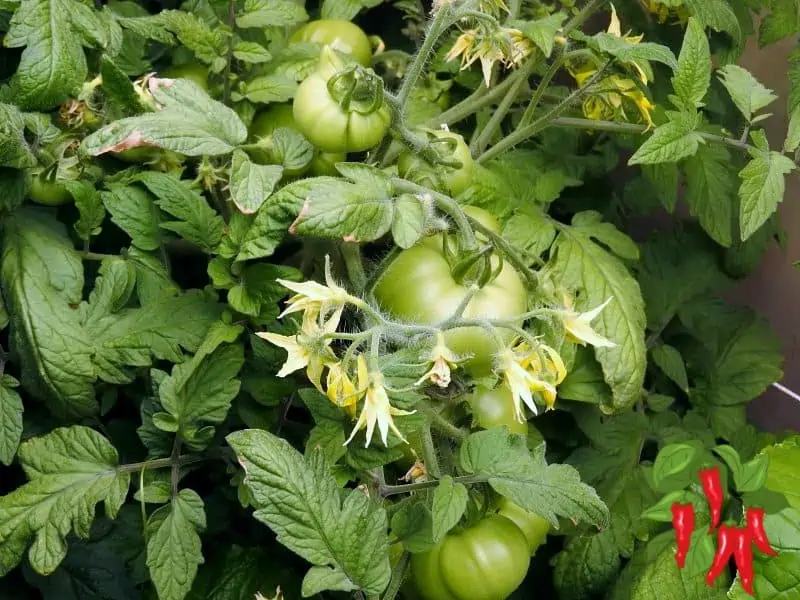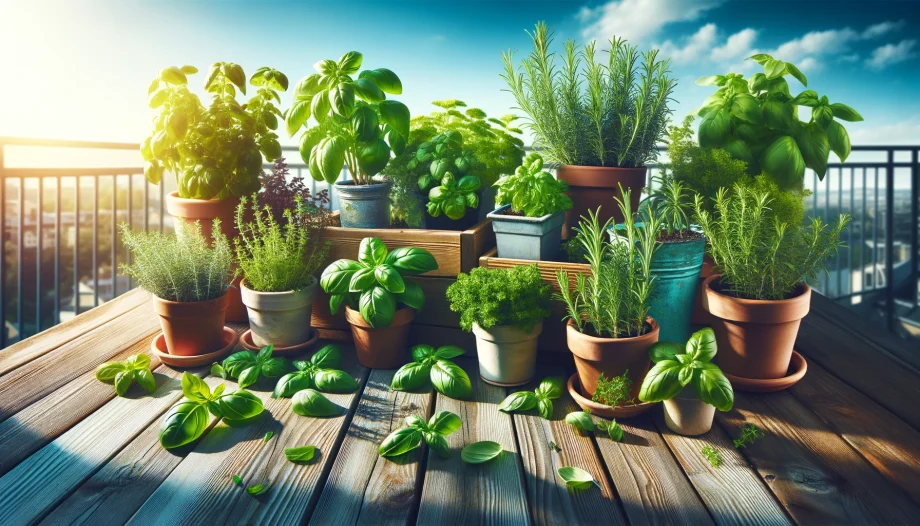This post may contain affiliate links. If you buy something from one of our links we may earn a commission. Thanks
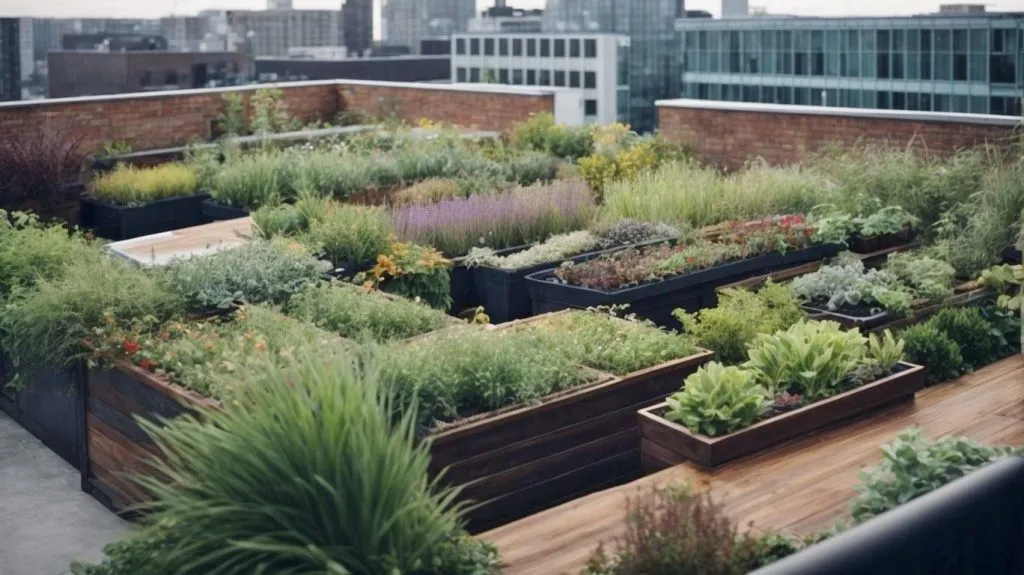
Howdy, green thumbs, and city dwellers! Are you ready to elevate your gardening game—literally?
If you’ve ever dreamed of turning that empty rooftop into a lush, vibrant oasis, then our guide Rooftop Garden Soil Mix is just what you need.
We’ll dive into the dirt on crafting the perfect soil mix that ensures your high-altitude plants survive and thrive.
Whether you’re a seasoned gardener looking to conquer new heights or a curious newbie with lofty aspirations, stick around!
We’re about to get our hands dirty with all the secrets to a blooming rooftop garden. Let’s turn that drab rooftop into your personal slice of paradise!
Key Takeaways: Rooftop Garden Soil Mix Tips
- The best soil mix for a rooftop garden should be lightweight, drain well, and be nutrient-rich.
- Use a mix of one-third perlite or vermiculite for drainage, one-third peat moss or coconut coir for moisture retention, and one-third compost for nutrients.
- This combination ensures healthy plant growth and vibrant gardens.
Introduction to Rooftop Garden Soil Mix Tips
Howdy, garden lovers! Ever dreamed of turning that empty rooftop space into a lush, green sanctuary? Well, you’re not alone!
Rooftop gardening is becoming a trendy way to bring a bit of nature into urban environments.
It transforms a barren space into a vibrant area of growth and offers a little slice of peace right above the hustle and bustle of city life.
Overview of Rooftop Gardening
But, let’s get our hands into the real dirt here. None of this would be possible without the right foundation, and I’m not just talking about the building!
The soul of any garden, especially a rooftop one, is its soil. Yep, that’s right, choosing the perfect soil mix is crucial for nurturing your plants and ensuring they thrive in an elevated environment.
It’s not just about piling some dirt up there; it’s about crafting the perfect bed where your garden can lay its roots.
- Space Utilization: Transforming unused rooftops into vibrant green spaces.
- Environmental Benefits: Reducing urban heat, improving air quality, and managing stormwater.
- Aesthetic and Recreational Value: Enhancing building aesthetics and providing a recreational space for residents and visitors.
Importance of Choosing the Right Soil Mix
So, why fuss over soil mix? Well, because your plants are only as good as the soil they grow in!
A well-composed soil mix supports your plants in several ways:
- It provides them with nutrients,
- Helps retain moisture,
- Offers proper drainage,
- Keeps those roots breathing and healthy.
Remember that your rooftop garden is isolated from Mother Earth’s soil itself so it can’t forage for nutrients unless you provide them.
In the compact space of a rooftop, every inch counts, so getting your soil mix right from the get-go sets the stage for a garden that’s not only surviving but thriving.
- Weight Considerations: Ensuring the soil is light enough not to compromise building safety.
- Moisture Management: Balancing water retention and drainage to suit rooftop conditions.
- Nutrient Richness: Providing all necessary nutrients through the right mix, enhancing plant health and vigor.
Stick around as we dig deeper into what makes a good soil mix, how to whip up your own, and some key tips to keep your rooftop garden blooming season after season.
Let’s turn that rooftop into a flourishing garden that’s the envy of the neighborhood!
What Is a Rooftop Garden?
Alright, let’s break it down. A rooftop garden? It’s exactly what it sounds like—a garden on the roof!
But it’s more than just slapping some plants up top and calling it a day. It’s about transforming unused rooftop spaces into vibrant ecosystems that can host a variety of plant life.
These gardens bring a touch of nature to the concrete jungle, turning underutilized spaces into productive and enjoyable landscapes.
Definition and Purpose
- Urban Oasis: Rooftop gardens provide a green retreat in urban settings, turning bland and often overlooked roof spaces into bustling hubs of plant life.
- Maximizing Space: Rooftop gardens make the most of unused vertical spaces in cities where every square foot counts.
Benefits of Rooftop Gardens in Urban Settings
- Environmental Impact: These gardens help reduce the urban heat island effect, which is when city regions experience much higher temperatures than their rural surroundings.
- Social and Psychological Benefits: They offer urban dwellers a chance to connect with nature, which can improve mood, reduce stress, and enhance overall well-being.
- Sustainability: By absorbing rainwater, rooftop gardens reduce runoff and decrease the load on sewer systems, promoting a more sustainable urban environment.
Role of Lightweight Materials and Proper Soil in Supporting Plant Health
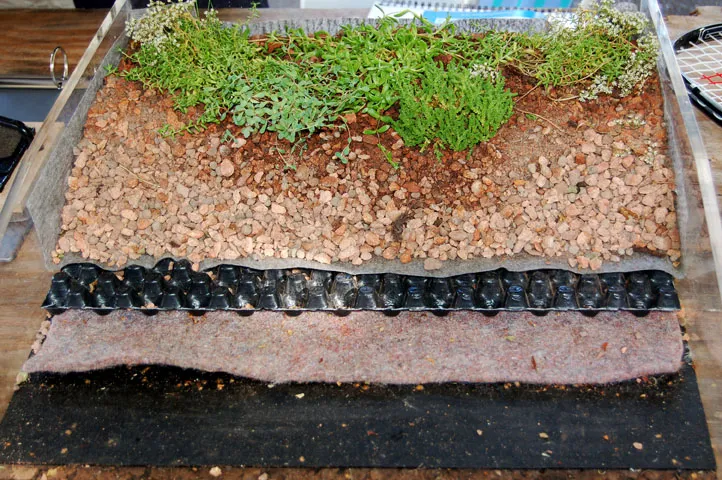
When setting up a garden in the sky, you can’t just use any old dirt. You need a soil mix that’s up to the challenge of a rooftop setting, and that’s where coco coir comes in as a game changer.
- Coco Coir: This lightweight, sustainable material is made from the fibrous husks of coconuts and is an excellent base for rooftop garden soil mixes. Coco coir is much lighter than traditional garden soils and has outstanding water retention properties, making it ideal for rooftop environments where water efficiency is crucial.
- Enhanced Drainage and Aeration: While coco coir is not nutrient-rich on its own, it provides an excellent structure for root growth due to its ability to retain moisture and promote proper drainage and aeration. This helps prevent root diseases and promotes healthy root development.
- Sustainability and Fertilization: Choosing coco coir reflects an eco-friendly choice, as it is a renewable resource unlike peat moss, which has raised environmental concerns over its extraction impacts. To compensate for its lack of nutrients, it’s important to pair coco coir with a good quality fertilizer. This ensures that your plants will receive the essential nutrients they need to thrive.
By incorporating coco coir into your rooftop garden’s soil mix and complementing it with the right fertilizers, you ensure that your garden is not only thriving but also sustainable.
So, whether you’re planning to grow a lush green roof or a productive vegetable patch, consider coco coir as your foundation. It’s about creating a sustainable, high-performing garden that rises above!
Why Is Soil Mix Important for Rooftop Gardens?
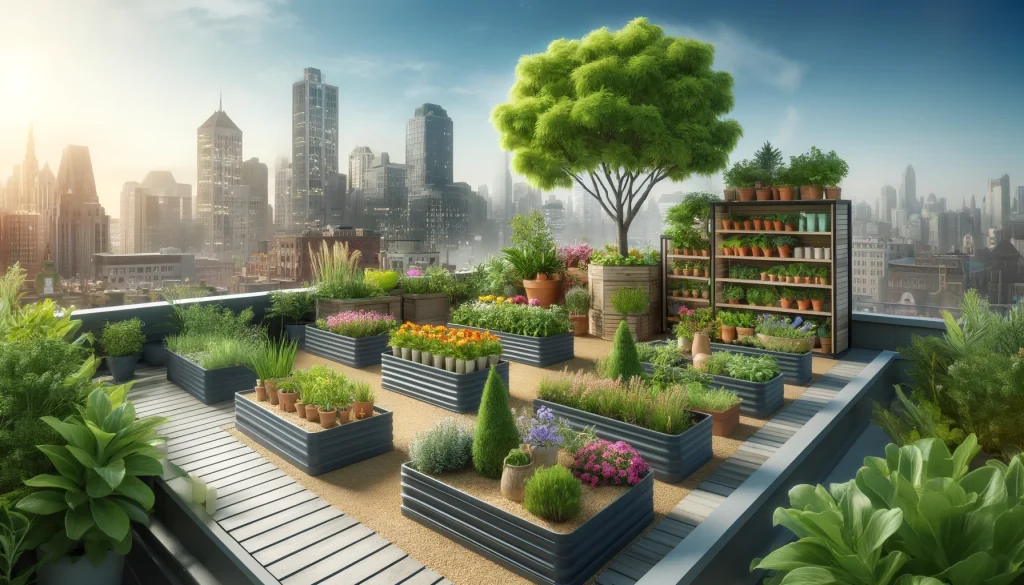
Now, why all the fuss about the right soil mix for your rooftop garden? Well, think of it this way: the soil mix is like the bed where your garden lays its roots.
It’s the foundation that supports everything above it. Let’s dig into why getting this foundation right is crucial for the success of your rooftop garden.
Importance of Drainage and Nutrient Provision
- Drainage: On a rooftop, there’s no room for error when it comes to drainage. Excess water needs a quick escape route, or you’ll run the risk of waterlogged plants. Good drainage in the soil mix helps prevent a slew of problems, including root rot, fungal infections, and structural damage to the building from standing water.
- Nutrient Provision: Rooftop gardens can’t just rely on the earth beneath them to provide nutrients—they don’t have any earth beneath them! This is where your soil mix steps in, armed with the nutrients your plants need to grow strong. Incorporating compost, slow-release fertilizers, or specifically tailored nutrient blends ensures that your plants won’t go hungry.
Impact of Soil Mix on Plant Health and Growth
- Root Health: A well-designed soil mix promotes healthy root systems. Roots need the right balance of air and water, plus room to grow. Compacted or poorly structured soil can stifle roots, literally choking your plants. On the flip side, a soil mix with good structure gives roots the space to expand and thrive.
- Plant Growth and Vigor: The quality of your soil directly affects the health and vigor of your rooftop garden. Plants grown in a rich, well-balanced soil mix will be more robust and productive. They’re more likely to bounce back from stresses like harsh weather or pest attacks and will yield more lush foliage and vibrant blooms.
Tailoring Soil Mix for Specific Needs
- Customizable Mixes: Different plants have different needs, and one of the great things about creating your own soil mix is that you can tailor it to suit whatever you’re growing. Want to plant a rooftop vegetable garden? You’ll need a mix that’s rich in nutrients and has excellent water retention. Planning a succulent garden? They’ll need a mix with sharper drainage and less organic material.
- Adaptability: The conditions on a rooftop can be pretty harsh, with more exposure to wind and sun than a ground-level garden. A good soil mix helps mediate these conditions, buffering plants from extreme temperatures and helping maintain moisture levels even on the hottest days.
In essence, the soil mix in a rooftop garden does a lot more than just hold your plants in place. It’s a crucial tool for ensuring drainage, providing nutrients, and creating an environment where plants can thrive despite the challenges of their elevated setting.
By giving your plants the best possible start with the right soil mix, you’re paving the way for a thriving, vibrant rooftop garden. Let’s keep those city views green and lush!
Pots vs. Open Soil: Choosing the Best Growing Method for Rooftop Gardens
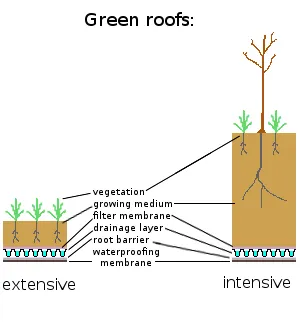
When setting up a rooftop garden, one of the first decisions you’ll need to make is whether to use pots and containers or to spread soil directly over the roof to create an open garden bed.
Each approach has its unique benefits and considerations. Let’s explore these options to help you determine the best method for your rooftop gardening ambitions.
Using Pots and Containers
- Flexibility and Control: Pots and containers offer unparalleled flexibility. You can easily move them around to optimize plant exposure to sun and shade, which is particularly useful in the dynamic environment of a rooftop. This mobility also allows you to rearrange your garden layout based on seasonal changes or aesthetic preferences.
- Ease of Maintenance: Container gardening simplifies maintenance tasks like watering, fertilizing, and pest control. Since each plant is contained, you can tailor your care to the specific needs of each plant without affecting others. This individualized approach can lead to healthier plants and higher yields.
- Reduced Structural Risk: Using pots limits the weight and distribution of soil on your rooftop, reducing the risk of overloading the structure. Lightweight pots, such as those made from plastic or fiberglass, add minimal weight and stress to the building.
Covering the Whole Roof with Soil
Intensive and extensive roofs are two types of green roofing systems, each designed with specific characteristics and for different uses:
Intensive Roofs:
These are essentially rooftop gardens that can support a wide variety of plants, including large shrubs and trees.
Intensive roofs are often accessible and can be used as recreational green spaces.
They require a deeper soil layer (typically 6 inches or more), substantial structural support due to their weight, and more maintenance, including regular watering, weeding, and fertilizing.
Extensive Roofs:
These roofs are designed to be low-maintenance and are not usually intended for public access.
They are covered with hardier, drought-resistant plants such as sedums and other succulents.
Extensive roofs require less soil depth (typically 2-6 inches), are lighter, and need minimal maintenance.
This makes them a more cost-effective and eco-friendly option for covering large areas that aren’t intended for foot traffic.
- Natural Insulation: Covering the entire roof with a layer of soil can provide excellent insulation for your building, reducing heating and cooling costs. This thick layer of soil and plants can shield your home from extreme temperatures, both hot and cold.
- Increased Growing Area: By spreading soil across the entire rooftop, you maximize your growing space, allowing for a larger variety of plants and more extensive landscaping options. This can be particularly appealing for creating large-scale green roofs that can host everything from small trees to expansive flower beds.
- Ecosystem Benefits: A full-coverage soil roof can support a wider range of biodiversity, attracting beneficial insects and even wildlife, depending on the size and design. This setup can create a mini-ecosystem, which enhances the environmental benefits of your rooftop garden, such as improving air quality and reducing urban heat.
Considerations for Choosing Between Pots and Open Soil
- Structural Integrity: Before deciding on an open soil roof, it’s crucial to consult with a structural engineer. The additional weight of a fully covered soil roof may require reinforcement of the existing roof structure to handle the load safely.
- Waterproofing and Drainage: Both options require effective waterproofing and drainage systems to protect the building. In open soil setups, ensuring proper drainage is critical to prevent water accumulation and potential damage. Containers naturally allow for better drainage control and can be fitted with individual drainage systems.
- Installation and Upkeep Costs: Installing a full soil roof can be more labor-intensive and costly compared to setting up containers. The ongoing maintenance of a full roof may also require more effort and resources, such as larger-scale irrigation systems and extensive weeding and maintenance.
Choosing between pots and open soil for your rooftop garden depends on your specific needs, the structural capacity of your building, and your gardening goals.
Pots provide ease and flexibility, while a full soil installation offers broader ecological benefits and the potential for a more dramatic transformation of your space.
Whichever you choose, both methods can transform a bare roof into a thriving green garden, bringing beauty and nature to your urban abode.
What Are the Components of a Good Soil Mix for Rooftop Gardens?
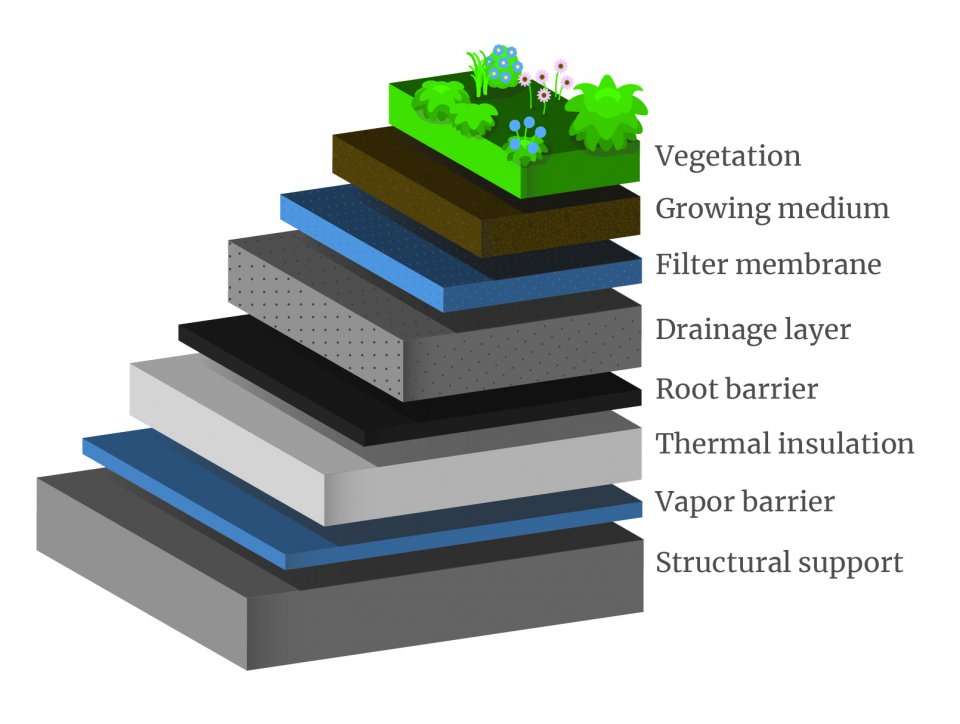
Creating the perfect soil mix for a rooftop garden is like crafting a gourmet recipe for your plants.
Each ingredient must be chosen with care to ensure the mix is light enough for a rooftop yet rich enough to support vibrant plant growth.
Let’s dive into the key components that make up a top-notch rooftop garden soil mix.
Lightweight Materials
- Why Lightweight: The importance of using lightweight materials can’t be overstated in rooftop gardening. These materials ensure that the structural integrity of the building is not compromised by excessive weight.
- Examples: Plastic pots are prime examples of lightweight materials that are perfect for rooftop settings. They reduce the overall load on your roof while still providing excellent support for your plants.
Benefits of Using Lightweight Options Like Plastic Pots
- Plastic Pots: These pots are a practical choice for rooftop gardens due to their light weight, durability, and flexibility. They come in various sizes and colors, allowing for customization of your garden layout and design.
- Advantages: Plastic pots are also cost-effective and widely available, making them accessible to all gardeners. They help prevent soil compaction, which is crucial for maintaining good air and water movement around plant roots.
Organic Matter
- Role of Organic Matter: Organic matter, such as coconut coir, is crucial for nutrient retention and soil structure. It helps to keep the soil aerated and moist, which is vital for root health.
- Importance of Coconut Coir: Coconut coir is particularly beneficial for rooftop gardens. It’s not only lightweight but also has a natural resistance to mold and rot, provides excellent water retention capabilities, and promotes strong root growth.
Nutrients
- Essential Nutrients: Plants need a variety of nutrients for robust growth, including nitrogen for leaf development, phosphorus for root growth, and potassium for overall health.
- Nutrient Provision: Since rooftop gardens can’t pull nutrients from the ground below, adding a balanced, slow-release fertilizer to the soil mix can provide a continuous supply of essential nutrients. This is crucial for sustaining plant health throughout the growing season.
Drainage Materials
- Why Drainage Matters: Proper drainage is essential to prevent waterlogging, which can lead to root rot and other water-related plant diseases.
- Effective Drainage Materials: Perlite, vermiculite, and sand are great additions to a soil mix for enhancing drainage. They keep the soil loose and airy, allowing water to flow through smoothly while still retaining adequate moisture.
By combining these components—lightweight materials, organic matter, essential nutrients, and effective drainage materials—you can create an ideal soil mix that supports healthy, thriving plants on your rooftop garden.
Each component plays a vital role in ensuring that your elevated garden not only survives but thrives, bringing lush greenery to urban skies!
How to Make Your Own Soil Mix for Rooftop Gardens?
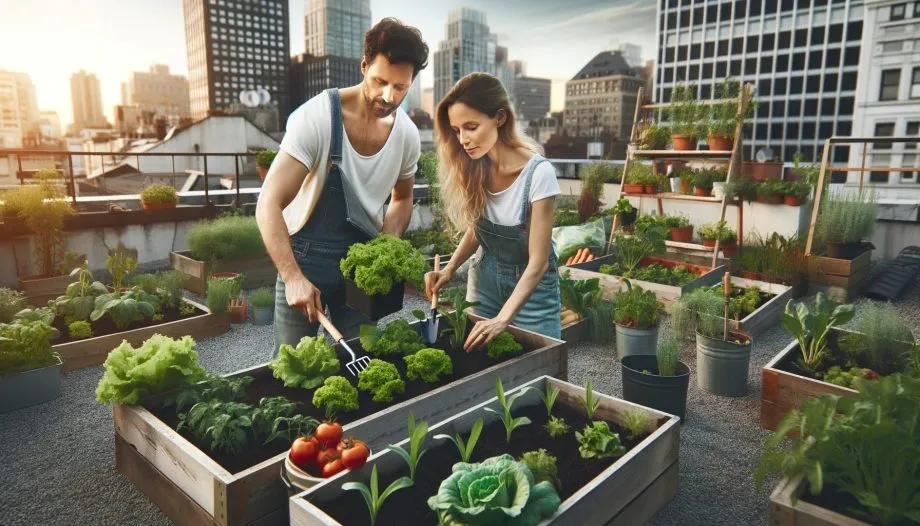
Creating your own soil mix for a rooftop garden is a rewarding DIY project that can significantly enhance the health and productivity of your plants.
Here’s a straightforward guide to mixing up the perfect rooftop garden soil.
Steps to Create a Custom Soil Mix
- Determine the Type of Plants to Grow
- Before you start mixing, think about what you want to grow. Different plants have different soil requirements. For example, succulents need well-draining soil to prevent root rot, while leafy vegetables might prefer soil richer in organic matter to support rapid growth.
- Calculate the Amount of Soil Mix Needed
- Measure the dimensions of your containers or the surface area of your rooftop garden to estimate how much soil you’ll need. A general rule of thumb is that a standard 12-inch pot requires about 4 gallons (15 liters) of soil. Adjust your calculations based on the depth and total number of containers or the total area of the garden.
- Gather Necessary Materials
- Collect the components you’ll need based on your plant’s needs. Typical materials include:
- Drainage materials: Perlite or vermiculite for improved aeration and drainage.
- Organic matter: Coconut coir or compost to help retain moisture and add nutrients.
- Structural materials: Sand or fine gravel to add bulk and improve drainage. Optional it’s heavy use light weight perlite instead.
- Nutrients: Slow-release fertilizers or specific nutrients tailored to the needs of your plants.
- Collect the components you’ll need based on your plant’s needs. Typical materials include:
- Mix the Ingredients
- Use a large container or wheelbarrow to mix your ingredients. Start by layering the bulky structural materials like sand or fine gravel. Add the organic matter next, then sprinkle in your drainage materials. Finally, incorporate the nutrients evenly throughout the mix.
- Mix thoroughly to ensure the components are evenly distributed. A garden fork or spade works well for this, but for larger quantities, you might consider using a cement mixer or a similar tool to get a consistent blend.
Tips for Perfecting Your Soil Mix
- Test Your Soil Mix: After mixing, it’s a good idea to test your soil mix for proper drainage and moisture retention. You can do this by watering the mix and observing how it absorbs and drains water.
- Adjust Based on Feedback: If your plants show signs of distress (like yellowing leaves for nutrient deficiencies or soggy stems for too much water), adjust your soil mix by adding more of the necessary component. For example, add more compost or a nutrient mix for deficiencies, or increase perlite content to improve drainage.
- Reevaluate Annually: Over time, soil can become compacted or depleted. Check your soil condition at the start of each growing season and replenish or remix as needed to maintain its quality.
By following these steps and tailoring your mix to the specific needs of your rooftop garden, you’ll create a vibrant, nurturing environment where your plants can thrive.
Remember, the key to a successful garden starts from the ground up—so invest some time and love into your soil!
Tips for Maintaining the Soil Mix in Rooftop Gardens
Maintaining the soil mix in your rooftop garden is crucial for ensuring your plants stay healthy and productive throughout the growing season. Here are some essential tips to help you keep your garden’s foundation in top shape.
Regular Checks for Moisture Levels
- Monitor Moisture Consistently: Use a soil moisture meter or your fingers to check the moisture levels of your soil regularly. Rooftop gardens can dry out faster than ground-level gardens due to higher exposure to wind and sun.
- Adjust Watering Accordingly: Based on your moisture checks, adjust your watering schedule to ensure your plants receive just enough water—neither too little nor too much. Consider setting up a drip irrigation system for consistent moisture and to reduce water usage and labor.
Adding Nutrients as Needed
- Observe Plant Health: Keep an eye on your plants for signs of nutrient deficiency, which can include stunted growth, pale or yellow leaves, and a lack of flowering or fruiting.
- Supplement Nutrients: Use a balanced, slow-release fertilizer to feed your plants. You might also consider adding compost or specific nutrient mixes during the growing season to address deficiencies and boost plant health.
Monitoring for Pests and Diseases
- Regular Inspections: Regularly inspect your plants for signs of pests and diseases. Look under leaves, around stems, and near the soil surface.
- Integrated Pest Management (IPM): Implement IPM practices by introducing beneficial insects, using barriers, and applying organic pesticides only as a last resort.
Keeping plants healthy and ensuring they are not stressed from poor nutrition or watering practices can also reduce pest and disease outbreaks.
Annual Replenishment of the Soil Mix
- Assess Soil Condition: At the end of the growing season, evaluate your soil’s condition. Look for signs of soil compaction, depletion of organic matter, or salt buildup.
- Refresh Soil Annually: Remove the top layer of soil and replace it with fresh compost and new soil mix. This replenishment will help maintain soil structure, improve nutrient content, and enhance the overall health of your garden.
Additional Maintenance Tips
- Aerate Your Soil: Periodically loosen the soil in your containers or garden beds to prevent compaction and promote oxygen circulation to the roots.
- Mulch: Applying a layer of mulch can help retain moisture, suppress weeds, and add organic matter as it decomposes. Suitable mulching materials for rooftop gardens include straw, shredded leaves, or wood chips.
By following these maintenance tips, you can ensure your rooftop garden’s soil remains fertile and vibrant, supporting a lush and productive garden that can be your urban oasis year after year.
Regular care and attention to your soil will pay dividends in the health and beauty of your rooftop garden.
Common Mistakes to Avoid When Creating a Soil Mix for Rooftop Gardens
Creating the perfect soil mix for a rooftop garden can be a bit of an art form, and like any art, it requires attention to detail and an understanding of the medium.
Here are some common mistakes to watch out for when crafting your soil mix, so you can avoid them and ensure your rooftop garden thrives.
Using Heavy Materials
- The Risk: Heavy materials like regular garden soil or dense clay can significantly increase the weight load on your rooftop, potentially compromising the structural integrity of the building.
- The Solution: Opt for lightweight materials such as perlite, vermiculite, peat moss, or coconut coir. These materials provide excellent aeration and moisture retention without adding excess weight.
Not Providing Enough Drainage
- The Risk: Insufficient drainage can lead to waterlogged soil, which is detrimental to plant health. Roots in overly wet soil can become deprived of oxygen, leading to root rot and other fungal diseases.
- The Solution: Ensure your soil mix includes ample drainage materials like perlite. Additionally, make sure containers have drainage holes, and consider using raised beds with built-in drainage systems.
Neglecting to Add Nutrients
- The Risk: Rooftop garden soil mixes can quickly become nutrient-depleted because they are isolated from the natural ecosystem that typically replenishes soil nutrients.
- The Solution: Regularly enrich your soil with compost or a balanced slow-release fertilizer appropriate for the types of plants you are growing. Monitor plant health for signs of nutrient deficiencies and adjust your supplementation accordingly.
Overlooking the Importance of pH Levels
- The Risk: Incorrect pH levels can lock out necessary nutrients, making them unavailable to your plants, which can stunt growth and reduce vitality.
- The Solution: Test the pH of your soil mix periodically using a simple pH test kit from your local garden center. Most plants thrive in a slightly acidic to neutral pH (around 6.0 to 7.0). Adjust the pH if necessary using lime to increase it or sulfur to decrease it, depending on your specific plant requirements.
- Coco coir is naturally neutral in pH at 5.5 and 6.5 but peat moss is highly acidic at 3.5 to 4.5 pH
By avoiding these common pitfalls, you’ll be well on your way to creating a sustainable and flourishing rooftop garden.
Remember, the right foundation in terms of soil quality is key to your garden’s success.
So, take the time to prepare your soil mix correctly, and you’ll enjoy the lush, vibrant results of your efforts above the cityscape.
FAQs About Rooftop Garden Soil Mix
Got questions about setting up your rooftop garden soil mix? You’re not alone! Here’s a handy FAQ section to help you get started on the right foot.
Whether you’re wondering about the best type of soil to use, how often to change it, or how to make your own, we’ve got the answers to help you grow a thriving rooftop oasis.
Q. What is the best soil mix for a rooftop garden?
A. The ideal soil mix for a rooftop garden is lightweight, well-draining, and nutrient-rich.
A mix of one-third perlite or vermiculite, one-third peat moss or coconut coir, and one-third compost or well-rotted manure works well for most plants.
This combination ensures good aeration, moisture retention, and a steady supply of nutrients.
Q. Can I use regular topsoil for my rooftop garden?
A. It’s best to avoid using regular topsoil in rooftop gardens. Topsoil is typically heavier and may not drain well enough for container or raised bed gardening. It may also contain bugs or diseases.
It can also put unnecessary stress on the structure of your building due to its weight. Lightweight commercial potting mixes or a custom mix using perlite, vermiculite, and compost are better choices.
Q. How often should I change the soil in my rooftop garden?
A. The soil in rooftop gardens should be refreshed or replaced every two to three years.
Over time, soil can become compacted and depleted of nutrients, which can affect plant health.
Regularly adding fresh compost can help extend the life of your soil, but a complete change is beneficial to maintain optimum plant health and vigor.
Q. Can I make my own rooftop garden soil mix?
A. Absolutely! Making your own soil mix allows you to tailor the components to the specific needs of your plants.
Start with a base of coarse material like perlite or vermiculite for drainage, add peat moss or coconut coir for moisture retention, and mix in compost or a balanced fertilizer for nutrients.
Adjust the proportions based on your plants’ needs and local climate conditions.
Q. What is the importance of adding compost to my rooftop garden soil mix?
A. Adding compost is crucial because it enriches the soil with organic matter and nutrients, which are essential for plant growth.
Compost also improves soil structure, enhances moisture retention, and encourages beneficial microbial activity.
These factors are vital for a healthy and productive garden, especially in an isolated environment like a rooftop.
Q. How can I test the quality of my rooftop garden soil mix?
A. You can test the quality of your soil mix by checking its texture, drainage, and nutrient content. Perform a simple jar test to see the proportions of sand, silt, and clay.
Use a home testing kit to measure pH and nutrient levels. Observing how water drains through the soil can also indicate if the mix is too dense or too loose.
Adjustments might be necessary based on these tests to create the perfect environment for your plants.
By keeping these FAQs in mind, you can ensure that your rooftop garden’s foundation is as robust as the plants it supports. Happy gardening!
Conclusion: Cultivating Success With Your Rooftop Garden Soil Mix
Crafting the perfect soil mix and maintaining it properly are critical steps toward ensuring the success of your rooftop garden.
As we wrap up our exploration of rooftop gardening essentials, let’s summarize some key takeaways and final thoughts to keep in mind as you cultivate your urban oasis.
Key Takeaways
- Lightweight Soil is Crucial: Always opt for a soil mix that’s light yet nutrient-rich to support plant health without burdening your rooftop structure.
- Drainage and Aeration: Ensure your soil mix provides excellent drainage and aeration to prevent waterlogging and promote healthy root development.
- Regular Nutrient Replenishment: Since rooftop gardens can’t tap into the ground’s natural nutrient sources, adding compost and other organic fertilizers is essential to keep the soil fertile and rich.
- Monitor and Adapt: Regularly check the moisture levels, pH, and nutrient content of your soil. Adapt your care routine based on these observations to address any issues proactively.
- Renew Soil Periodically: Refresh or replace your soil every two to three years to combat compaction and nutrient depletion, ensuring your garden remains a vibrant and productive space.
Embracing the Urban Green
Rooftop gardening transforms unused urban spaces into green sanctuaries that offer not only aesthetic and recreational benefits but also environmental advantages.
By understanding the components of a good soil mix, how to maintain it, and the common pitfalls to avoid, you’re well on your way to creating a flourishing garden that rises above the cityscape.
Remember, the success of your garden starts from the ground up—with the soil. So, invest the time and effort into getting it right, and you’ll enjoy the lush, vibrant results of your labor.
Here’s to your rooftop garden becoming a thriving testament to the beauty and resilience of nature in the urban jungle! Happy gardening!
Read more: Rooftop Gardening Ideas: 7 Tips and Tricks For Beginners
Visit my Amazon Influencer Page for videos and gardening products Grow Your Own Garden




